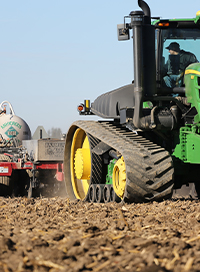 For 45 years, N-Serve® nitrogen stabilizer has helped take corn yield to the Nth degree. In other words, it’s the product farmers have been able to rely on to protect anhydrous ammonia applications and ensure a good return on investment for decades.
For 45 years, N-Serve® nitrogen stabilizer has helped take corn yield to the Nth degree. In other words, it’s the product farmers have been able to rely on to protect anhydrous ammonia applications and ensure a good return on investment for decades.
As we embark on a new year, let’s take a closer look at N-Serve and what makes it such a trusted tool in a farmer’s toolbox.
A Venerable History
In the late 1950s, scientists for The Dow Chemical Company discovered the nitrification-inhibiting ingredient nitrapyrin. Those scientists introduced nitrapyrin to the greater scientific community in 1962.
In 1974, the U.S. Environmental Protection Agency granted registration for the active ingredient in what would become a (then) Dow AgroSciences nitrogen stabilizer. Finally, in 1976, the brand N-Serve nitrogen stabilizer was introduced in the United States for use with anhydrous ammonia.
When farmers first heard about the product, they were naturally skeptical. It was hard to tell how it worked or if it worked right away in the field. However, in the years that have passed since it was introduced, N-Serve has been proven to keep nitrogen in the root zone for when corn needs it most, helping to maximize yield.
Proven Results
In the last 45 years, there have been more than 1,000 trials and university studies that show N-Serve works. There is data to back it up.
One meta-analysis of more than 180 of those studies found that N-Serve, powered by Optinyte® technology, does the following:
- Boosts yield by 5.2% with spring anhydrous ammonia applications and 7% with fall applications
- Extends nitrogen availability up to eight weeks
- Reduces leaching by 16%
- Increases soil nitrogen retention by 28%
- Lessens greenhouse gas emissions by 51%
N-Serve does all this by working below ground where up to 70% of nitrogen loss happens from leaching and denitrification.
The product slows down Nitrosomonas bacteria, which convert stable ammonium nitrogen to unstable nitrate nitrogen. Nitrate is easily lost into groundwater when it rains via leaching and into the atmosphere via denitrification. When nitrogen stays in the ammonium form longer, it’s more likely to remain in the root zone and be there when corn needs it during key growth stages.
N-Serve Today
Today, N-Serve continues to be a product you can trust to protect anhydrous ammonia. Consider it when you’re thinking about spring applications.
Aside from the economic and environmental benefits previously mentioned, N-Serve provides these agronomic benefits:
- Increased grain protein
- More natural crop drydown
- Improved standability
- Reduced stalk rot
2021 has just begun. We don’t know what the year holds or what exactly the weather will bring this spring. But we do know N-Serve can help protect your nitrogen investment. After all, it’s been proven to do just that over 45 years.
Watch testimonial videos featuring fellow farmers who rely on the trusted stabilizer to protect their anhydrous ammonia.
1 Wolt, J. D. 2004. A meta-evaluation of nitrapyrin agronomic and environmental effectiveness with emphasis on corn production in the Midwestern USA. Nutrient Cycling in Agroecosystems. 69: 23–41.
Do not fall-apply anhydrous ammonia south of Highway 16 in the state of Illinois. Always read and follow label directions.
The More You Grow
Find expert insights on agronomics, crop protection, farm operations and more.